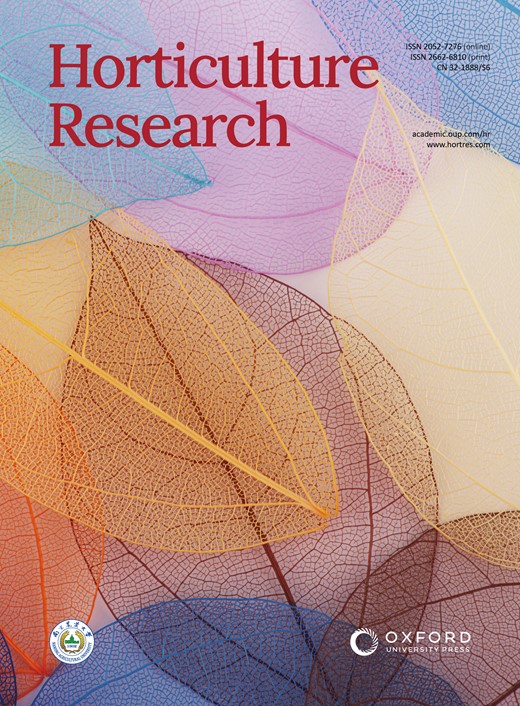E3泛素连接酶SlATL2通过促进SlCSN5a在丁香假单胞菌pv中的降解来抑制番茄免疫。番茄DC3000感染
IF 8.5
1区 农林科学
Q1 Agricultural and Biological Sciences
引用次数: 0
摘要
植物免疫涉及复杂的调节机制,介导对病原体的防御反应的激活。通过泛素化的蛋白质降解在调节这些防御中起着至关重要的作用,E3泛素连接酶起着中心调节作用。本研究研究了定位于质膜上的拟南芥(ARABIDOPSIS) TÓXICOS EN LEVADURA (ATL)型E3泛素连接酶SlATL2在番茄植株对丁香假单胞菌pv免疫应答中的作用。番茄(Pst) DC3000。我们的研究结果表明,Pst DC3000感染和防御激素水杨酸(SA)和茉莉酸(JA)处理诱导了SlATL2的表达。功能上,SlATL2负性调节免疫应答,削弱对Pst DC3000的抗性,抑制flg22触发的免疫。此外,SlATL2通过靶向COP9信号体亚基5a (SlCSN5a)来限制病原体诱导的活性氧(ROS)和胼胼质积累,而COP9信号体亚基5a是番茄对Pst DC3000防御反应的关键正调节因子。这种相互作用通过SlATL2的n端残基发生,导致SlCSN5a泛素化和26S蛋白酶体降解,从而抑制sa依赖性防御反应基因的表达,限制ROS的产生。这项工作揭示了E3泛素连接酶SlATL2通过靶向COP9信号体亚基降解来减弱番茄免疫反应的分子机制。这些发现加深了我们对控制植物免疫反应的翻译后机制的认识,并为加强作物对细菌病原体的抗性提供了新的机会。本文章由计算机程序翻译,如有差异,请以英文原文为准。
The E3 ubiquitin ligase SlATL2 suppresses tomato immunity by promoting SlCSN5a degradation during pseudomonas syringae pv. Tomato DC3000 infection
Plant immunity involves complex regulatory mechanisms that mediate the activation of defense responses against pathogens. Protein degradation via ubiquitination plays a crucial role in modulating these defenses, with E3 ubiquitin ligases functioning as central regulators. This study investigates the role of SlATL2, an ARABIDOPSIS TÓXICOS EN LEVADURA (ATL)-type E3 ubiquitin ligase localized in the plasma membrane, in the immune response of tomato plants against Pseudomonas syringae pv. tomato (Pst) DC3000. Our findings demonstrate that SlATL2 expression is induced upon Pst DC3000 infection and treatment with defense hormones salicylic acid (SA) and jasmonic acid (JA). Functionally, SlATL2 negatively regulates immune responses, impairing resistance to Pst DC3000 and suppressing flg22-triggered immunity. In addition, SlATL2 limits pathogen-induced reactive oxygen species (ROS) and callose accumulation by targeting the COP9 signalosome subunit 5a (SlCSN5a), a key positive regulator of tomato defense responses against Pst DC3000. This interaction, which occurs via the N-terminal residue of SlATL2, results in the ubiquitination and 26S proteasomal degradation of SlCSN5a, thereby suppressing SA-dependent expression of defense response genes associated and limiting ROS production. This work sheds light on the molecular mechanism through which the E3 ubiquitin ligase SlATL2 attenuates tomato immune responses by targeting a COP9 signalosome subunit for degradation. These discoveries deepen our insights into the post-translational mechanisms governing plant immune responses and provide fresh opportunities to bolster crop resistance against bacterial pathogens.
求助全文
通过发布文献求助,成功后即可免费获取论文全文。
去求助
来源期刊

Horticulture Research
Biochemistry, Genetics and Molecular Biology-Biochemistry
CiteScore
11.20
自引率
6.90%
发文量
367
审稿时长
20 weeks
期刊介绍:
Horticulture Research, an open access journal affiliated with Nanjing Agricultural University, has achieved the prestigious ranking of number one in the Horticulture category of the Journal Citation Reports ™ from Clarivate, 2022. As a leading publication in the field, the journal is dedicated to disseminating original research articles, comprehensive reviews, insightful perspectives, thought-provoking comments, and valuable correspondence articles and letters to the editor. Its scope encompasses all vital aspects of horticultural plants and disciplines, such as biotechnology, breeding, cellular and molecular biology, evolution, genetics, inter-species interactions, physiology, and the origination and domestication of crops.
 求助内容:
求助内容: 应助结果提醒方式:
应助结果提醒方式:


